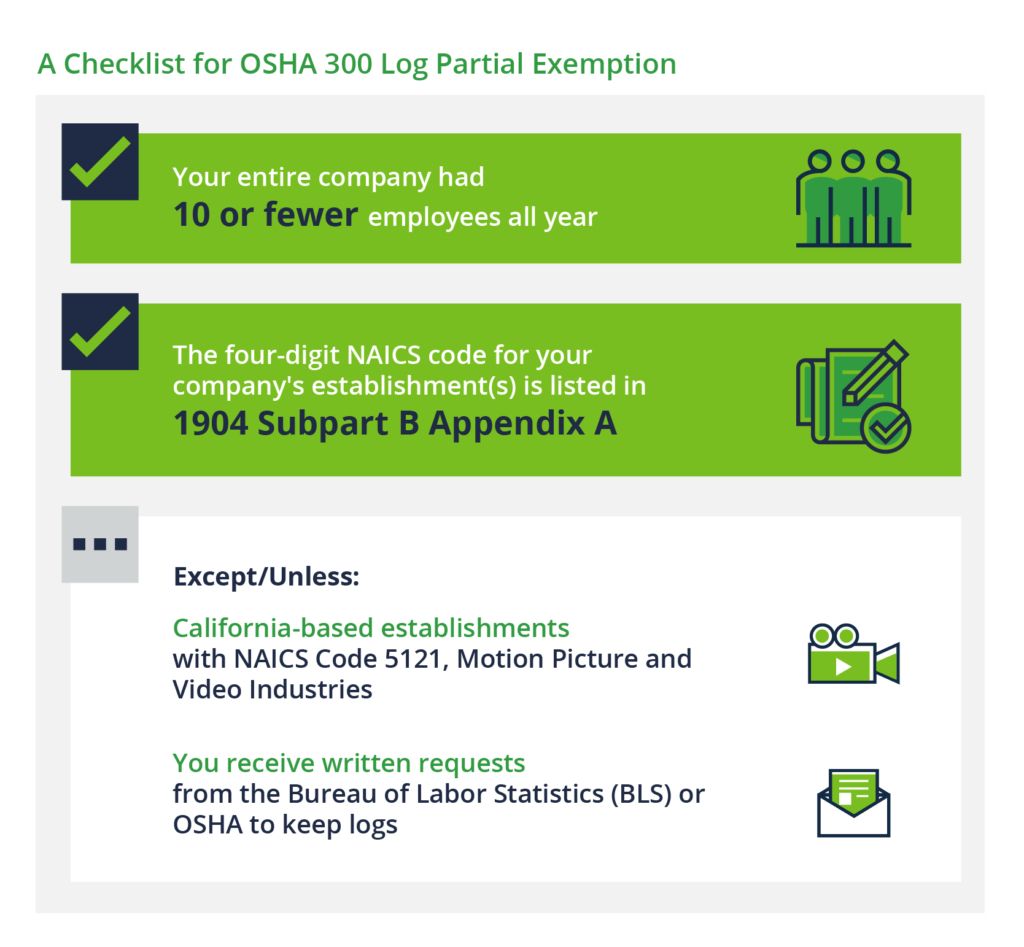Blog
OSHA 300 Logs: Which Company Locations Are Partially Exempt?
Over the last few years, several aspects of the Occupational Safety and Health Administration's (OSHA) reporting requirements have generated numerous questions and confusion for employers, even for those familiar with OSHA compliance items. Partial exemption is one of the most frequently asked-about aspects of OSHA recordkeeping.
If your company has more than 10 employees at any point in the year, OSHA requires you to complete Form 300 (also known as the OSHA Log of Injuries and Illnesses) to record work-related illnesses and injuries. This holds true except in the case of "partially exempt" locations.

Are All Employers Required by Law to Keep OSHA 300 Logs?
The simple answer is no, but determining whether a company's location or locations are what OSHA calls partially exempt can be tricky. Partial exemption means that an establishment doesn’t have to complete the 300 log, the 300A annual summary, 301 forms, or electronic reporting. This, of course, means that the time, expense, and effort involved in keeping these records can be redirected.
|
Read Our Series of Articles on OSHA 300 Logs: |
Are There Other Reasons to Keep 300 Logs?
Some companies keep OSHA injury and illness records for all locations despite some or all of those locations being partially exempt. This is generally for the sake of developing OSHA rates for marketing, safety metrics, or contracting. If you find that your company has locations with a 4-digit North American Industry Classification System (NAICS) code on the partially exempt list, you may wish to coordinate internally with marketing, safety, and finance before discontinuing recordkeeping for those establishments.

Does My Company Have Locations That Qualify for Partial Exemption?
There are two ways an employer as a whole or some of its locations—or "establishments," as OSHA terms it—can be partially exempt:
- If your entire company had 10 or fewer employees at all times last year, you are partially exempt from keeping OSHA 300 injury and illness records
- The next category of partial exemption is determined by individual establishment. A company can have both partially exempt and non-exempt establishments. If the four-digit NAICS code for the main activity performed at an establishment is listed in 1904 Subpart B Appendix A, then that specific establishment is partially exempt. If all locations for a company have a partially exempt four-digit NAICS code on this list, then no injury or illness records would be required by law for the company as a whole.
| OSHA Definition of Establishment: An establishment is a single physical location where business is conducted or where services or industrial operations are performed. For activities where employees do not work at a single physical location, such as construction; transportation; communications, electric, gas and sanitary services; and similar operations, the establishment is represented by main or branch offices, terminals, stations, etc., that either supervise such activities or are the base from which personnel carry out these activities. |
The spectrum of business establishments on the partially exempt list is wide. Some examples include many types of retail establishments, establishments doing software development, law offices, financial offices, and outpatient healthcare offices. Corporate headquarters that primarily conduct the office-based management and support of a company are also partially exempt. To know for sure which of your establishments are partially exempt, we strongly recommend reviewing the full list.
An example of a company that would be required by law to keep a log for one establishment but not another would be a computer and electronics manufacturing company that has a production facility and an engineering office at different locations. Assuming the primary activity that occurs at the manufacturing location falls under NAICS 334111, which is a computer and electronics manufacturing code, that establishment would need to keep a 300 log. The second facility falls under 5415, which is found on the partially exempt list, so this establishment does not need to complete the 300 log, 300A summary, 301 forms, or electronic injury or illness record reporting.
If you are having trouble figuring out whether a mixed-use establishment is partially exempt, start by determining what the primary activity of that location is. According to the NAICS association, the US Census Bureau methodology is “to assign one NAICS code to each establishment based on its primary activity (the activity that generates the most revenue for the establishment)."
Are There Exceptions to Partial Exemption?
Partial exemption can be overridden by two organizations. The first is the Bureau of Labor Statistics (BLS) and the second is OSHA itself. If the BLS or OSHA requests in writing that you keep logs, you must do so, regardless of your partially exempt status.
In the case of the BLS, a company is notified in writing of the requirement to keep these records for the following year. The BLS randomly selects establishments to survey after grouping them based on location, industry, and number of employees. The BLS keeps injury statistics by NAICS codes and anyone can access the aggregated statistics built using the requested data.
In the case of OSHA, this is generally done as part of a site visit citation settlement and action plan, or a complaint letter action plan, and will be outlined in the written documentation the company receives.
California's Exception to Partially Exempt NAICS Codes
In California, establishments in NAICS Code 5121, Motion Picture and Video Industries are required to keep OSHA injury and illness records despite being partially exempt federally.
Serious Injury Reporting Is Always Mandatory
Being partially exempt from keeping 300 logs does not mean an employer does not have to report serious injuries to OSHA. There are some minor state differences, but the main things to remember are that all work-related injuries resulting in in-patient hospitalization for treatment, a fatality, an amputation, or loss of an eye require reporting to OSHA.
OSHA provides a link to the federal reporting information as well as to each state’s requirements and an explanation of what triggers serious injury reporting. Reporting timelines range from an eight-hour deadline when dealing with fatalities to a 24-hour deadline when dealing with non-fatal injuries. Some states hold to an eight-hour time frame for all serious injuries.
If you have questions about partial exemption or any other OSHA reporting issue, contact any member of your Woodruff Sawyer account team or Stephen Glazier directly.
Author
Table of Contents












